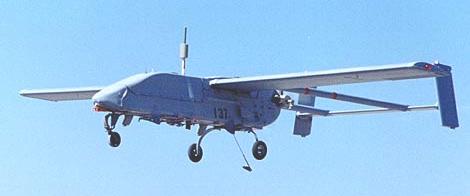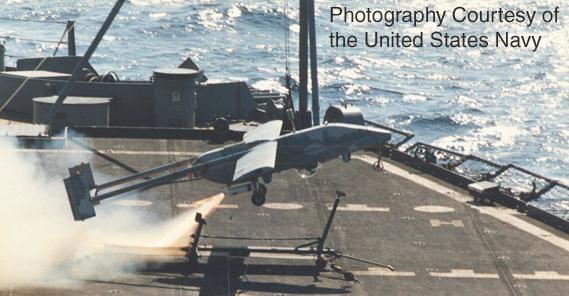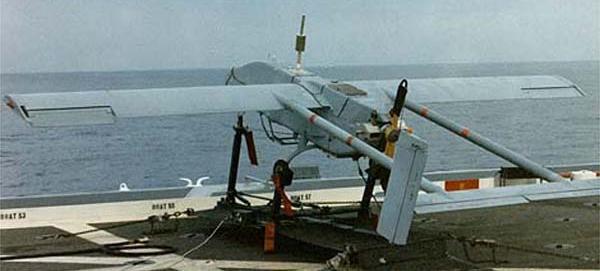IAI/AAI RQ-2 Pioneer
The U.S. Navy's Pioneer was the first tactical battlefield UAV in service with the U.S. armed forces. Israel Aircraft Industries (IAI) began its development in 1984 as an improved derivative of their Scout tactical UAV. In 1985, the U.S. Navy conducted a fly-off for a short-range ship-board reconnaissance UAV between the Pioneer and the Pacific Aerosystems Heron. In January 1986, the Pioneer was declared the winner, and within the following two years orders were placed for nine complete systems (UAVs + ground equipment) with a total of about 50 air vehicles. Deliveries to the Navy began in July 1986, followed by the U.S. Marine Corps in July 1987 and the U.S. Army in March 1990. At that time, the Navy deployed their Pioneer systems from Iowa class battleships, while the U.S. Marine Corps employed two Pioneer units on land bases. Initially the Pioneer UAV did not receive an official military designation, but when the DOD introduced a new Q-for-UAV category in its aircraft designation system in January 1997, it was finally designated RQ-2A. In the USA, the prime contractor for the RQ-2 is Pioneer UAV Inc., a joint venture between IAI and AAI Corp.
 |
| Photo: U.S. Navy |
| RQ-2A |
The RQ-2A is of twin-boom pusher configuration and is powered by a single Sachs & Fichtel SF2-350 two-cylinder two-stroke piston engine. When deployed on land bases, the UAV can either take off conventionally on its non-retractable tricycle landing gear, or be launched by a catapult or a rocket booster. On U.S. Navy ships, the Pioneer is launched by a MK 125 MOD 2 solid-propellant rocket booster, giving a thrust of 3.78 kN (859 lb) for 2 seconds. The UAV can either land on a runway using a tailhook to catch an arresting wire, or fly into a recovery net (for ship-board recovery). It is equipped with an autopilot, an inertial navigation system and a two-way C-band datalink. Although it can fly a preprogrammed mission, the usual mode of operation is manual remote control using video provided by the datalink. Maximum range of the line-of-sight datalink is 185 km (100 nm). The RQ-2A can be equipped with a wide variety of mission payloads, and one of the most imporant ones is the Wescam DS-12 EO/IR (Electro-Optical/Infrared) sensor. Typical tasks for the UAV are naval gunfire support, reconnaissance, target acquisition and BDA (Bomb Damage Assessment).
 |
| Photo: U.S. Navy |
| RQ-2A |
The Pioneer UAVs were first used operationally in Operation Desert Storm in early 1991. They were quite successful and their deployment significantly contributed to the increasing recognition of UAVs as valid combat elements in the 1990s. Since then, the Navy has retired its battleships, but there are five Austin class amphibious landing ships, which were modified to deploy a Pioneer system if the need arises. The U.S. Army's Pioneer systems were transferred to the Navy in 1995, after the former service had received BQM-155/RQ-5 Hunter UAVs as replacement.
During the 1990s, about 50 additional RQ-2 airframes were delivered, mainly as attrition replacements. A number of improvements have been implemented, and therefore the latest batch of new-built RQ-2s, ordered in 1997, has been designated RQ-2B. This variant is equipped with UCARS (UAV Common Automatic Recovery System) and MIAG (Modular Integrated Avionics Group). 33 older RQ-2A have also been upgraded to RQ-2B standard.
 |
| Photo: U.S. Navy |
| RQ-2A |
By 2004, six Pioneer systems were still in service with the Navy and Marine Corps. Originally it had been planned to begin retirement in 2003 and replace the RQ-2B with the RQ-8A Fire Scout VTUAV, but the delays in that program mean that Pioneer will last several years longer. In fact, existing RQ-2Bs are upgraded to RQ-2C standard to ensure an operational combat capabiloty until 2015. Upgrades in the RQ-2C include a new UEL AR-741 rotary engine and an IR laser designator.
Specifications
Note: Data given by several sources show slight variations. Figures given below may therefore be inaccurate!
Data for RQ-2A (except where noted):
| Length | 4.27 m (14 ft 0 in) |
| Wingspan | 5.15 m (16 ft 10.75 in) |
| Height | 1.00 m (3 ft 3.5 in) |
| Weight | max: 205 kg (450 lb); empty: 178 kg (392 lb) |
| Speed | max: 204 km/h (127 mph); cruise: 120 km/h (74 mph) |
| Ceiling | 4570 m (15000 ft) |
| Range | 185 km (100 nm) |
| Endurance | 5 h |
| Propulsion | Sachs & Fichtel SF2-350 piston engine; 19.4 kW (26 hp) RQ-2C: UEL AR-741 rotary engine; 28.3 kW (38 hp) |
Main Sources
[1] Kenneth Munson (ed.): "Jane's Unmanned Aerial Vehicles and Targets, Issue 15", Jane's, 2000
[2] Tom Kaminski: "The Future is Here", article in Combat Aircraft Vol. 4, No. 6, 2003
[3] Kenneth Munson: "World Unmanned Aircraft", Jane's, 1988
Back to Directory of U.S. Military Rockets and Missiles, Appendix 2
Last Updated: 25 July 2007